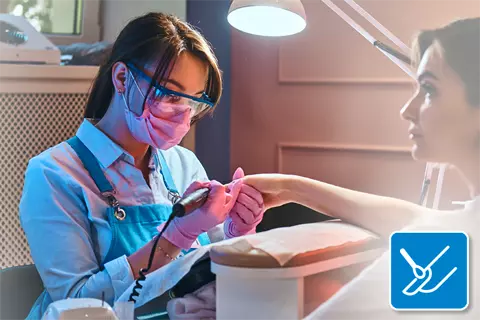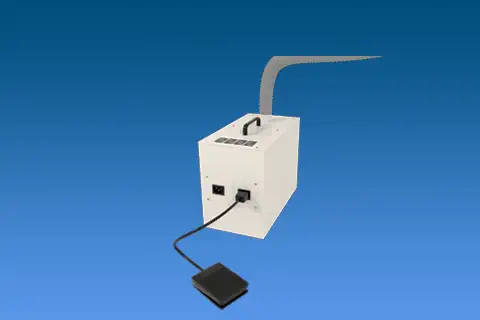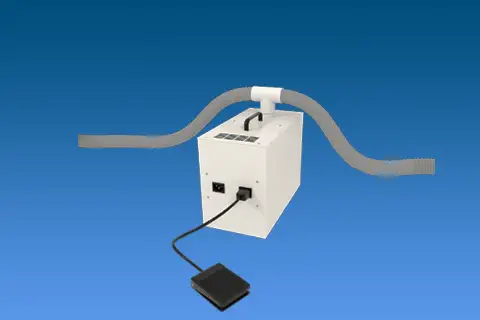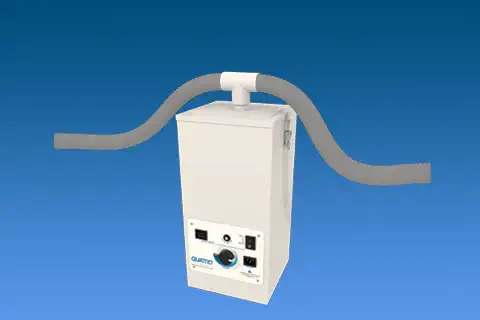Nail Salons
Overview
 Nail salons provide clients with an array of services such as manicures, pedicures and waxing. But the price of this beauty comes at a cost. Many of the chemicals used in nail salons give off gasses, vapors and dust making them some of the most heavily polluted businesses. Walk into any nail salon today and the first thing you may notice will be a strong chemical smell. That odor reveals just how contaminated the indoor air quality (IAQ) is in most modern nail salons.
Nail salons provide clients with an array of services such as manicures, pedicures and waxing. But the price of this beauty comes at a cost. Many of the chemicals used in nail salons give off gasses, vapors and dust making them some of the most heavily polluted businesses. Walk into any nail salon today and the first thing you may notice will be a strong chemical smell. That odor reveals just how contaminated the indoor air quality (IAQ) is in most modern nail salons.
The use of products like nail polishes, nail polish removers, acrylic nails, glues, solutions, creams and hardeners all pollute indoor air. But chemicals are not the only problem plaguing nail salons. Dust produced from filing nails and reducing calluses also contribute to poor IAQ. Overtime, the constant buildup of these toxins makes maintaining good air quality challenging. The problem is compounded in shops with limited space as the concentration levels for these pollutants tends to be higher.
Long-term exposure to these toxins can lead to serious health consequences. Recognizing the dangers of indoor air pollution in salons, many states like New York now have IAQ guidelines to protect workers. Of all the recommended measures, source capture exhaust ventilation is the most preferred method of reducing exposure to indoor air pollutants.
Air Quality Challenges
Nail salon workers are routinely exposed to a number of indoor air pollutants that can adversely affect their health. The worst offenders include:
- Chemicals/ Volatile Organic Compounds (VOCs)
- Nail and Acrylic Dusts
- Blood Borne and Infectious Diseases
- High Carbon Dioxide Levels
Chemicals/ Volatile Organic Compounds (VOCs)
The off gassing of chemicals used daily in nail salons produces volatile organic compounds (VOCs). When inhaled, VOCs can have a disastrous effect on the health of workers. Four of most concerning offenders include:
- Toluene. Regulated by the U.S. Occupational Safety and Health Administration (OSHA), toluene is a common ingredient found in fingernail polish and glue. If inhaled, toluene can cause dizziness, lightheadedness or drowsiness. High exposure can damage the nervous system, impair kidney function and irritate the eyes, lungs or throat. Pregnant individuals should avoid this chemical as it can cause birth defects, slow growth and learning disabilities. OSHA has set the daily exposure limit at 200 parts per million (ppm) during an 8 hour work shift. Some states mandate even lower concentrations. California, for example, requires no more than 10 ppm for the same period.
- Dibutyl Phthalate. Used to make nail polish and hardeners more pliable, dibutyl phthalate is banned in the European Union (EU). Exposure to this chemical can lead to nausea and irritation of the respiratory tract and eyes. Reproductive issues such as developmental defects, reduced sperm count and changes in the testes and prostate are also a risk.
- Formaldehyde. Yet another banned substance by the EU, formaldehyde is used in nail polishes and hardeners. Formaldehyde is a known carcinogen. Other side effects include eye, skin and throat irritation; coughing; allergic reactions; asthma-like attacks and breathing difficulty.
- Methacrylate Compounds. Both ethyl and methyl methacrylate can be found in nail salons but when it comes to toxicity, the two chemicals are quite different from each other. Methyl methacrylate (MMA) is extremely dangerous and despite it being banned in 30 states, it can still be found in many salons. A bonding agent, MMA is so toxic that the FDA cautions against its use. Exposure can cause eye, nose, throat, and respiratory tract irritation; drowsiness; dizzy spells and hand trembling. More serious effects include miscarriages, kidney lesions, liver problems, permanent respiratory issues and cancer. Ethyl methacrylate (EMA), a type of acrylic liquid that has become standard in nail products, is much safer but still poses some risks such as allergies, asthma and dermatitis.
Nail and Acrylic Dusts
Along with polishing and applying nails, nail technicians spend much of their day buffing calluses and filing nails. These activities generate nail and acrylic dust that pose inhalation hazards and cause eye irritation.
Nail and acrylic dusts contain a number of harmful toxins that could adversely affect the health of workers including:
- Microorganisms such as bacteria, fungi, yeasts, dermatophytes and saprophytes.
- Acrylics from artificial nails.
- Chemicals from nail polish.
- Keratin
- Keratin hydrolysates
Some of these dusts are too large to be inhaled and pose little risks. The smaller ultrafine particles are more of a concern as they can easily be inhaled and deposited deep into the lungs, not to be exhaled again, leading to severe lung and nose irritation. In other more serious cases, these particles can pass through lung tissue and enter the bloodstream.
Long term exposure can lead to itching, inflammation and conjunctivitis. Other common respiratory health issues associated with nail and acrylic dusts include:
- Headaches
- Loss of Sense of Smell
- Respiratory Allergies/ Allergic Hypersensitivity
- Sinusitis
- Rhinitis
- Asthma
Bloodborne and Infectious Diseases
But the indoor air pollutants are not limited to just nail dust and chemicals. Nail technicians and clients are also at risk of contracting bloodborne and infectious diseases in salons.
Nail salons service a wide variety of clientele, some of whom may be carrying viruses such as HIV and hepatitis B and C. Workers may be exposed to these viruses when removing the calluses of an infected person as they can become aerosolized. Nail technicians are also at risk from breathing in fungal infections when working on a client’s feet or nails.
Without proper air filtration, bacteria and viruses can spread and linger indoors, sometimes for hours at a time. The onset of the Covid pandemic has highlighted the need for better air filtration and ventilation. To protect staff and clients from both bloodborne and infectious disease, an effective air purifier with proper filtration is essential.
High Carbon Dioxide Levels
High carbon dioxide levels can also adversely affect the IAQ in nail salons. Smaller, densely populated salons with little to no filtration are particularly at risk. Elevated carbon dioxide has been linked to illnesses such as sick building syndrome and can lead to poor concentration, reduced cognitive performance and respiratory issues.
According to the American Society of Heating, Refrigerating, Air-Conditioning Engineers (ASHRAE), CO2 concentrations should be lower than 1000 parts per million (ppm) to maintain good air quality. Sadly, many indoor establishments exceed these levels. To achieve good air quality and reduce CO2, installing a system that filters and ventilates the air is essential.
The American National Standards Institute (ANSI)/ American Society of Heating, Refrigerating and Air Conditioning Engineers (ASHRAE) have guidelines for ventilation system design for acceptable IAQ. Standards 62.1 and 62.2 outline minimum ventilation rates and other measures salons can take to curtail the adverse health effects of poor air quality.
Solutions for the Nail Salon Industry
To protect workers and clients, nail salons must address IAQ in their establishments. Source capture systems help contain hazardous dust and particles while air purifiers can ventilate and clean polluted indoor air.

K1 Compact Infinity
Source Capture for Debris
With foot-pedal, 6 feet of 1.5" diameter hose. Portable with compact space-saving design.
Part Number#: 1-0024-0003
>> View Product Details

K1 Compact
Source Capture for Debris
With "T", 2 x 6 ft long 1.5" diameter hoses & foot-pedal. Ideal for for nail dust.
Part Number#: 1-0024-0005
>> View Product Details

MedEVAC Mini
Stationary Model
With "T", 2 x 6 ft long 1.5" diameter hoses & foot-pedal. Ideal for for nail dust.
Part Number#: MEM-217KRC
>> View Product Details

Accessories
Attachments, Arms & Controls
Explore our vast selection of available accessories & attachments.
Download Accessories Brochure